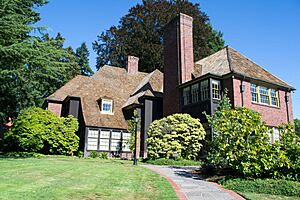Eastmoreland, Portland, Oregon facts for kids
Quick facts for kids
Eastmoreland
|
|
|---|---|
|
Neighborhood
|
|
| Country | United States |
| State | Oregon |
| City | Portland |
| Area | |
| • Total | 1.14 sq mi (2.95 km2) |
| Population
(2000)
|
|
| • Total | 5,017 |
| • Density | 4,405/sq mi (1,700.7/km2) |
| Housing | |
| • No. of households | 1630 |
| • Occupancy rate | 96% occupied |
| • Owner-occupied | 1459 households (90%) |
| • Renting | 171 households (10%) |
| • Avg. household size | 3.08 persons |
Eastmoreland is a lovely, tree-filled neighborhood in Portland, Oregon, United States. It was built in the early 1900s. The neighborhood got its name from a local real estate developer named Judge J.C. Moreland.
Contents
What's Eastmoreland Like?
Eastmoreland is located in inner southeast Portland. It is known for its many trees and beautiful gardens.
The neighborhood has clear boundaries:
- To the north, it's bordered by SE Woodstock Boulevard.
- To the west, you'll find SE McLoughlin Boulevard, SE Reedway Street, and SE 26th Avenue.
- Johnson Creek forms most of the southern edge.
- The eastern boundary is near SE Tenino Street, SE Crystal Springs Boulevard, and SE César E. Chávez Boulevard.
- The northern border also goes around the Reed College campus.
You can find several public parks in Eastmoreland:
- Crystal Springs Rhododendron Garden (opened in 1923)
- Eastmoreland Golf Course (opened in 1916)
- Eastmoreland Garden (opened in 2004)
- Eastmoreland Playground Park (opened in 1916)
- Berkeley Park (opened in 1941)
There's also a green area on Reed College Place. It is cared for by Portland Parks & Recreation.
Eastmoreland is home to two schools:
- Duniway Elementary School, built in 1926 and named after Abigail Scott Duniway.
- Holy Family Catholic School.
Protecting Eastmoreland's History

There has been a big discussion about making a part of Eastmoreland a "historic district." This means the area would be officially recognized for its important history and older buildings. The proposed district covers about 475 acres in southeast Portland. It is generally bordered by Woodstock Boulevard, Cesar Chavez Boulevard, 36th Avenue, Berkeley Park, Crystal Springs Boulevard, 27th Avenue, and 28th Avenue.
Why a Historic District?
The Eastmoreland Neighborhood Association suggested this idea. They wanted to help save older homes from being torn down or changed too much. If an area becomes a historic district, there are rules about how homes can be changed or expanded. This helps keep the neighborhood's original look and feel.
The Big Discussion
Not everyone agreed with the idea of a historic district. Some homeowners worried that these rules would stop them from updating or expanding their houses as they wished. This led to a lot of debate in the community.
In 2017, the Portland Historic Landmarks Commission and a state committee supported the idea. This seemed to put the district on track to become official. However, residents who disagreed could submit formal objections. If enough objections were received, the plan could be stopped.
Counting the Objections
A tricky situation came up in 2018. Some homeowners used a special legal method involving "trusts" to submit many more objections. This made it seem like there were enough objections to block the historic district.
The neighborhood association felt this was unfair. They believed it went against the true wishes of the community. According to federal rules, if more than half of the property owners in an area object, it cannot be listed as a historic district.
In 2022, a court reviewed how these objections were counted. A new rule was made for counting them. A new application will now be sent to the National Park Service to decide the future of the proposed historic district.
Images for kids





